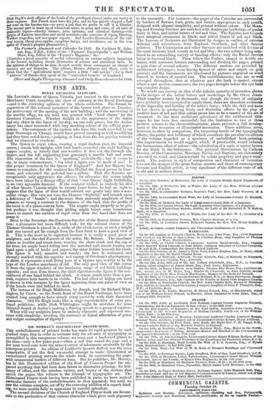MR. MURRAY'S ILLUMINATED PRAYER-BOOK.
Tan embellishment of printed books has made its rapid progress by such gradual steps, that in order to estimate duly the advance of typography as exemplified in this sumptuous volume, we must cast a backward glance to the time—only a few years past—when a red line round the page and a few neat wood-cuts were the utmost extent of adornment attainable by the letterpress-printer. An edition of Lockhart's Spanish Ballads was the most remarkable, if not the first successful attempt to make illuminated or Varicoloured printing pervade the whole book, by surrounding the pages With ornamental borders of different hues. But its publisher, Mr. Murray, has hi this illuminated edition of the Book of Common Prayer far sur- passed anything that had been done before in decorative printing: for bril- liancy of effect, and the number, variety, and beauty of the devices that enrich the pages, this volume is the triumph of typographic art. The Illuminated Prayer-book having been published in parts, we have noticed Particular features of the embellishments as they appeared; but until we fylw the volume complete, set off by the crowning addition of a superb bind- ing, we were unable fully to appreciate its tasteful splendour.
-The several divisions of the Church of England Prayer-book are favour- able to the production of that various character which gives such piquancy to the ensemble. For instance—the pages of the Calendar are surrounded by borders of' flowers, fruit, grain, and berries, appropriate to each month, designed with elegant simplicity, and printed without colour. The Morn. ing and Evening Services are enriched with Arabesque borderings of quaint fancy in blue, and initial letters of red and blue. The Epistles and Gospels have marginal ornaments in black, and initial letters of red and black. The Lessons of Scripture are illustrated by designs in outline, of extreme delicacy and minuteness, from Raphael, Overbeck, and other famous painters. The Communion and other Services are enriched with devices of the most intricate kind, mostly in red and blue; the two colours being com- bined in an astonishing variety of dazzling effects; only the Burial Service being in funereal black. Then follow the Psalms, ranged in double co- lumns, with narrower borders surrounding and dividing the pages, printed in pale tints of several colours. The different sections are preceded by emblazoned titlepages; some having figures of saints and angels on gold ground; and the Sacraments are illustrated by pictures engraved on wood framed in borders of neutral tint. The embellishments, too, are so well arranged throughout, that at whatever part the book is opened, except where a new section commences, the two pages brought before the eye form one complete design.
No words can convey an idea of the infinite quantity of invention shown in the designs of the initial letters and borderings by Mr. Owen Jones. Their number counts by thousands; and though the stores of antiquity have probably been ransacked to supply them, there are abundant evidenoes of the ingenuity and fertility of the artist's fancy; while the skill and taste he has shown in producing lively and dissimilar effects by the play of positive hues of red and blue colour prove bins to be a master of the art of ornament. In the more ambitious splendours of the emblazoned title- pages he has been less successful; but the limitation to two or three positive colours in the chromalithographic plates prevents a full develop- ment of the resources of illuminated decoration. These additions serve, however, to show by comparison, the surpassing merits of the typographic effects; the purity and brilliancy of which constitute the peculiar excellence of the volume regarded as a specimen of embellished book-printing. One improvement we would suggest, which, if practicable, would enhance the harmonious effect of colour—the substitution of a sepia or umber brown for the black in the letterpress. The pictorial illustrations, by Callcott Horsley, of the Communion, Marriage, Burial, and Baptism, are elaborately executed on wood, and characterized by sedate propriety and grave senti- ment. The contrast in style of composition and character of invention between the designs of the great Italian masters and those of contemporary German and English artists, is very significant of the different state of art in old and in modern times.


























 Previous page
Previous page